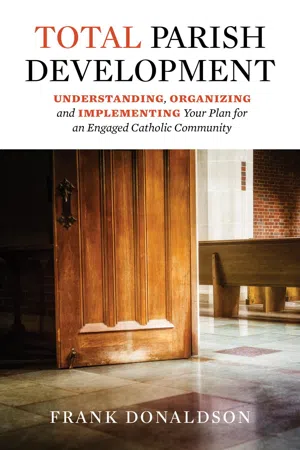![]()
Part I
Introduction
History and Rationale
In 2015, I wrote a book titled 25 Lessons Learned in 25+ Years in Catholic School Development. It was published by the National Catholic Educational Association (NCEA) in March 2016. Shortly thereafter, I wrote a workbook to accompany the text, published by NCEA in November 2017, and the Institute for School and Parish Development now use both publications to teach Catholic schools about setting up successful development and advancement efforts.
At the time, I did not realize the need for such publications, but this became very noticeable when ISPD—Institute for School and Parish Development, the Catholic consulting company I founded in 1989—formed a partnership with the University of Dayton in 2017, and we, along with Sister Angela Zukowski, MHSH, D.Min., executive director for the Institute for Pastoral Initiatives, began to teach online certificate courses using the textbook and the workbook. The first ten-lesson course was offered in the fall of 2017, and we had 190 students enrolled from across the country. As of the spring semester 2019, we now have taught over 1,000 students (superintendents, principals, pastors, presidents, development and/or advancement officers, board members, faculty/staff, parent volunteers, etc.). People from more than 100 dioceses have participated in 25 Lessons Learned: Part I and Part II.
It is through these relationships, connections, and associations that we realized the unbelievable thirst that leaders in Catholic institutions have for learning more about development. Many do not have the time or the budget to attend faraway conferences and conventions, but they are able to learn with an online course where they can receive Continuing Education Units (CEUs) and a Certificate of Completion from The University of Dayton.
Therefore, after we completed the textbook and workbook in Catholic school development, many people encouraged us to do the same for Catholic parishes—where the need is just as great, if not greater. We now are excited to offer a combination textbook/workbook in Catholic Parish Development—made possible by having worked as a Catholic parish/school consultant for the past 30+ years throughout the country.
In addition, in the fall of 2018, we added a course to the curriculum we are offering through the University of Dayton—Catholic Parish Development: Beyond Mediocrity. This course, which we are now teaching, has 112 students from 52 dioceses. We are following the fifteen lessons of this book, Total Parish Development, and the response and the discussions and sharing of homework assignments has been contagious. Many parishes are excited about learning, and a number of parishes, not being content with doing what they have always done, are “putting out their nets into the deep.” They seem to be ready for real cultural change. As one student recently stated in his final exam project, “The real challenge for our parish leaders was actually understanding the real meaning of Catholic Parish Development.”
I would like to share these experiences and lessons with you. I only wish I would have had someone or something to guide me along the way and let me know what to do and what not to do when I was starting my development journey. There is a lot that is available in development/advancement for Catholic schools, but there is not a lot that is available in development for Catholic parishes. Sure, there are fund-raising companies and webinars on how to write letters and how to increase your offertory giving. There are companies that can come in and show you how to run a capital campaign. There are database companies, special event companies, and others. But that is not what this book is about. This publication and this journey are about teaching you how to set up and establish a successful Catholic Parish Development system in your parish—one that will invite and involve people, and one that will move your parish to total parish development. If ever in the history of the Catholic Church there were a time when we needed to reach out and affirm, welcome, and engage, now is that time.
![]()
Part II
Philosophy and Fundamentals of Catholic Parish Development
“Our Christian identity is belonging to a people: the Church. Without the Church we are not Christians.” POPE FRANCIS
Lesson One: Understand Catholic Parish Development and Its Importance
The first two decades of the twenty-first century might long be remembered as challenging years in this country, and, more specifically, in the Catholic Church. The events of September 11th, the constant ups and downs of the economy, the closing of a number of Catholic churches and schools, and daily headlines addressing the sexual misconduct of some clergy—these have all rocked the foundation of many Catholic dioceses, parishes, and schools. Those of us who work in the ministry of developing Catholic institutions continue to be challenged and to be called upon to set forth positive action that will build community, engage people, and build faith in our Catholic parishes and schools. The call for leadership has never been stronger. In fact, just today, I received an e-mail from one of my students in the online class I am teaching in Catholic school development who said, “The Catholic ‘pull’ is not very popular this year. I am in a highly rated public-school district, so competition is tough. Timing is bad with the child abuse priest scandal that just came out across our state. I don’t want to downplay a faith-centered school, but it is not a ‘pull’ right now. Any suggestions?”
CATHOLIC DEVELOPMENT: A KEY ANSWER
There are several ways to address these challenges, but the one that we see making the most impact is development. A key word. A key initiative. Unfortunately, it is a word that has been misunderstood for many years. So many Catholic leaders see development as the main way of getting money for their parish and/or school. Whereas fundraising can be one of the components of development, as we stated in the Introduction, we see development in a broader sense. We define development as the meaningful involvement of people in your mission and vision for the future. And the key word is meaningful. People do want to get involved; people do want to feel like they belong.
With all that has happened, there continues to be a strong cry throughout this country for Catholic institutions to straighten their ship, create a dynamic vision and plan, chart a course of positive direction, invite hundreds to get involved, and then set sail. In the past at many parishes and schools, this has been done with a selected circle of people; today, we find that more and more folks want to be invited; they want to belong; they want to help create that new vision, that new plan, that new ministry, that new program.
It is all about engaging people. By analogy, here is what we see over and over every day in this ministry of Catholic consulting. In most parishes and schools, if I drop a pebble in a pond, the first ripple is usually about 25–50 people. These are usually the leaders, the ones who are asked to do everything. They are the parish council members, the festival chairs, the ministry leaders, and those on the finance committee. And, if the truth be known, most parishes and schools could not do without them. The problem? Possible burnout, and many times these people are always asked to do everything; therefore, very few new people become involved. It usually points to a statement that we at ISPD strongly believe: The greatest challenge we face today in our Catholic parishes and schools is not raising money. The greatest challenge we face is in creating the roadways, avenues, and vehicles to invite, involve, and engage people.
The second ripple is another 50 or more people who do not get involved, and they do not step forward because of one basic reason: no one invites them—personally. We create bulletin and newsletter announcements, put out flyers, post on our website, ask people to sign up for this and that, send out social media messages and e-mails, but very few Catholic leaders actually extend a personal invitation—eyeball to eyeball. There is one thing that years and years of consulting h...

